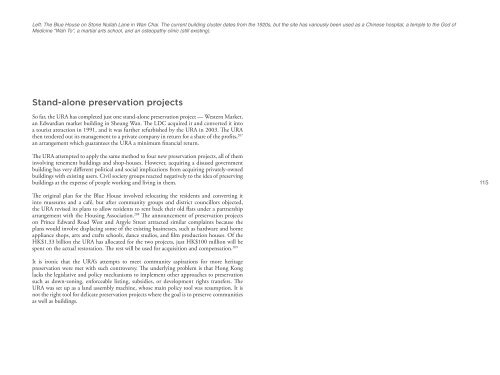Treating the Symptoms - A Critical Review of ... - Civic Exchange
Treating the Symptoms - A Critical Review of ... - Civic Exchange
Treating the Symptoms - A Critical Review of ... - Civic Exchange
- No tags were found...
Create successful ePaper yourself
Turn your PDF publications into a flip-book with our unique Google optimized e-Paper software.
Left: The Blue House on Stone Nullah Lane in Wan Chai. The current building cluster dates from <strong>the</strong> 1920s, but <strong>the</strong> site has variously been used as a Chinese hospital, a temple to <strong>the</strong> God <strong>of</strong>Medicine “Wah To”, a martial arts school, and an osteopathy clinic (still existing).Stand-alone preservation projectsSo far, <strong>the</strong> URA has completed just one stand-alone preservation project — Western Market,an Edwardian market building in Sheung Wan. The LDC acquired it and converted it intoa tourist attraction in 1991, and it was fur<strong>the</strong>r refurbished by <strong>the</strong> URA in 2003. The URA<strong>the</strong>n tendered out its management to a private company in return for a share <strong>of</strong> <strong>the</strong> pr<strong>of</strong>its, 207an arrangement which guarantees <strong>the</strong> URA a minimum financial return.The URA attempted to apply <strong>the</strong> same method to four new preservation projects, all <strong>of</strong> <strong>the</strong>minvolving tenement buildings and shop-houses. However, acquiring a disused governmentbuilding has very different political and social implications from acquiring privately-ownedbuildings with existing users. Civil society groups reacted negatively to <strong>the</strong> idea <strong>of</strong> preservingbuildings at <strong>the</strong> expense <strong>of</strong> people working and living in <strong>the</strong>m.115The original plan for <strong>the</strong> Blue House involved relocating <strong>the</strong> residents and converting itinto museums and a café, but after community groups and district councillors objected,<strong>the</strong> URA revised its plans to allow residents to rent back <strong>the</strong>ir old flats under a partnershiparrangement with <strong>the</strong> Housing Association. 208 The announcement <strong>of</strong> preservation projectson Prince Edward Road West and Argyle Street attracted similar complaints because <strong>the</strong>plans would involve displacing some <strong>of</strong> <strong>the</strong> existing businesses, such as hardware and homeappliance shops, arts and crafts schools, dance studios, and film production houses. Of <strong>the</strong>HK$1.33 billion <strong>the</strong> URA has allocated for <strong>the</strong> two projects, just HK$100 million will bespent on <strong>the</strong> actual restoration. The rest will be used for acquisition and compensation. 209It is ironic that <strong>the</strong> URA’s attempts to meet community aspirations for more heritagepreservation were met with such controversy. The underlying problem is that Hong Konglacks <strong>the</strong> legislative and policy mechanisms to implement o<strong>the</strong>r approaches to preservationsuch as down-zoning, enforceable listing, subsidies, or development rights transfers. TheURA was set up as a land assembly machine, whose main policy tool was resumption. It isnot <strong>the</strong> right tool for delicate preservation projects where <strong>the</strong> goal is to preserve communitiesas well as buildings.
















